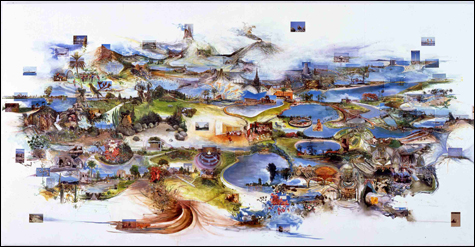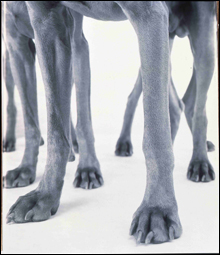
THE TILTED CHAIR (2003): The 16-foot-wide collage represents some of Wegman’s finest work. |
In 1970, William Wegman was making short videos — jumping around in his underwear with purses hanging all over him, that sort of thing. And his new dog, a Weimaraner he’d named Man Ray, after the Surrealist photographer, liked to wander about the edge of the frame. Wegman had become a casual sort of artist, so he left the dog in. Soon the dog became one of the main attractions.
In one video from that time, Wegman crawls backward on his hands and knees spitting a line of milk upon the floor until he disappears behind a corner. Then Man Ray appears from behind the corner licking up the milk until he bumps into the camera. People laughed. Before long, Wegman became known as the artist with the Weimaraner.
The Addison Gallery’s new Wegman retrospective, “Funney/Strange,” organized for the Andover institution by guest curator Trevor Fairbrother, points out that there’s lot more to Wegman than Weimaraners. But I have to report that, with a few exceptions, the Weimaraners remain his best stuff.
Wegman was born in Holyoke in 1943 and studied painting at MassArt (class of ’65). In grad school in Illinois, he quit painting Frank Stella knockoffs and, after a detour as a sculptor, wound up a very serious conceptual artist. It was a very serious time in art, dominated by the puritanical rigor of minimalism and conceptual art. Wegman very seriously flung Styrofoam letters and punctuation marks into a river and tossed plywood shapes into the air while friends photographed him and taped Band-Aids to his face in the shape of the word “wound.”
Like the Addison’s recent shows of Chuck Close and Jennifer Bartlett, the Wegman show traces the way artists in the 1970s left the fundamentalism of minimalism and conceptualism and returned to representation — though they never totally abandoned the faith. For those who weren’t around then, it’s hard to see what all the fuss was about. Young artists today mix and match lavish imagery and minimalism and storytelling and whatever else they desire without thinking twice about it. But back then, in the endgame of high Modernism, that stuff was sacrilege as the avant-garde obsessed over the elemental nature of art. Is a blank canvas art? What happens if you get rid of the canvas? Is an idea enough to be art?
Wegman felt he’d reached a dead end with his minimalist conceptualist works. His “eureka,” as he later called it, came in 1970 when he drew little circles on his hand to match the shape of the stones of his ring before heading out to a party. There he discovered that the circles on his hand matched the peppercorn rings in slices of salami. He dashed home, bought his own salami, arranged it on a plate and photographed his hand, with ring and drawn-on circles, reaching for a slice. Wegman’s way out of his corner, the way out of all that deadly pretentious seriousness, was — ta-dah! — slight punning jokes.
By 1972, he’d acquired Man Ray and was living in New York. His art remained serious ruminations on perception and semiotics but disguised as kiddie jokes and find-the-hidden-picture games. He photographed twin sisters and circled their identifying facial differences. He doodled pages of V-shaped birds and waves to ask what’s the difference between one mark and the other. He photographed Man Ray on a rocky beach and then carefully painted the pooch out. He photographed a woman seated on an exercise machine and doodled around the handles to make them resemble men’s penises. Tee. Hee.

UNTITLED (1998): Art folks are embarrassed by Wegman’s dog photos, but art audiences are desperate for a laugh. |
Wegman made clunky videos in which he imitated how-to demonstrations and commercials. In one, he sprays deodorant under his arm for the entire minute he testifies to the product’s clutch-moment effectiveness. In Spelling Lesson (1973-’74), Man Ray sits at a table while Wegman explains how he’s done on a spelling quiz. He’s spelled “park” and “out” correctly, but “beach” is wrong, to which the dog, right on cue, sadly whines. It’s this sort stuff that got Wegman gigs making videos for Saturday Night Live and Sesame Street.The problem is that the jokes mostly aren’t funny — except in the mildest, safest, lamest sit-com way. The reason Wegman passes for “hilarious” (as the textbook historian H.H. Arnason described him) is that art audiences are so desperate for a laugh, they’ve lowered the bar for humor almost to the floor.
The great New Yorker cartoonist Saul Steinberg covered this same semiotics stuff first and did it better and funnier — examining how language and symbols like Santa Claus, Uncle Sam, and the Statue of Liberty function in our politics and economy. Mike Kelley followed Wegman’s slacker jokes into rich, uncomfortable gags about middle-class American culture. But it’s silly to criticize Wegman for not being deep or funny, because his ultimate subject is goofing off, carelessness, offhandedness, half-assedness, failure.